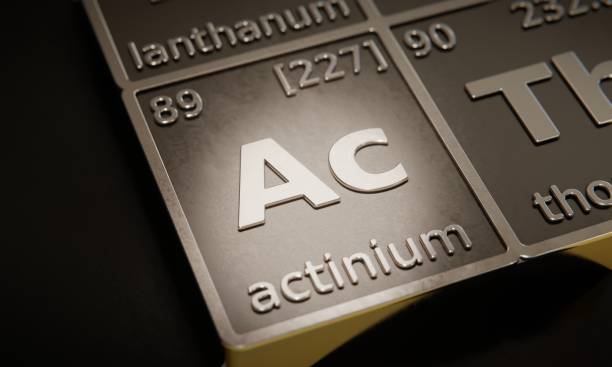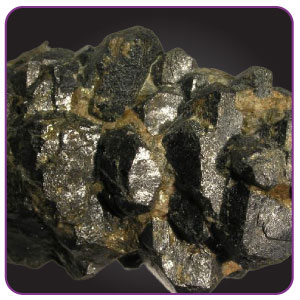Identity.
Actinium, element 89, lurks in the shadows of the periodic table, a
rare and radioactive gem. Gleaming with a faint blue glow due to its
potent alpha radiation, it's 150 times more intense than radium!
Chemically akin to lanthanum, this elusive element hides within
uranium ores, posing a challenge to isolate. Though limited in current
applications, research delves into its potential for targeted cancer
therapy, harnessing its power with precision. Actinium, with its
radioactive identity, remains a captivating enigma whispered of in
scientific quests.
Atomic Structure:
Actinium, element 89, packs a radioactive punch within its 89 protons
and 138 neutrons (in its most stable form). Its seven electron shells
hold the key to its behavior: two "valence electrons" in the outermost
shell readily detach, turning Actinium into a positively charged metal
ion. This, combined with its large size and unique electron
arrangement, gives it a chemical personality quite different from its
neighbors. While fascinating, this structure also makes Actinium
highly radioactive, emitting alpha particles and glowing with an eerie
blue light.
History.
In 1899, French chemist André-Louis Debierne glimpsed a faint glow
while studying pitchblende residues. This elusive luminescence,
initially confused with another element, was actually actinium, named
after the Greek word for "ray" due to its radioactivity. However,
credit wasn't so simple. Just three years later, German chemist
Friedrich Oskar Giesel independently discovered the same element,
unaware of Debierne's work, and named it "emanium." The debate over
who truly found it lasted for years.
In recent years, advancements in technology have shed light on
actinium's secrets. Research is exploring its potential in diverse
fields, including targeted alpha therapy for cancer treatment. Its
powerful radioactivity, once a hindrance, is now seen as a tool
for precise destruction of diseased cells. While its use remains
limited due to safety concerns, actinium's future shines with
promising possibilities, beckoning scientists to unlock its full
potential.
The "Radium Girls," young women painting watch dials with luminous
radium paint, bore the brunt of its hidden dangers. Tragically
exposed to radiation without knowledge or protection, they
developed horrific illnesses, eventually leading to stricter
regulations and a sobering understanding of radium's destructive
potential. While its medical applications continue in carefully
controlled settings, radium serves as a chilling reminder of the
need for scientific responsibility and caution in the face of
powerful discoveries.
Usage.
Though rare and radioactive, actinium isn't entirely without purpose.
It holds potential in targeted cancer therapy, delivering precision
strikes with alpha particles directly to tumors. Research explores its
use as a neutron source for scientific studies and, historically, it
peeked into smoke detectors. However, safety always prevails, limiting
its applications and prompting ongoing research to unlock its
potential responsibly. Actinium, a fascinating yet powerful element,
awaits its future chapters to be written by science's cautious hand.
-
Scientific Research: Actinium continues to be extensively
studied by scientists due to its unique properties and potential
applications in various fields, including nuclear medicine,
materials science, and environmental studies. However, these
studies prioritize safety and containment due to the element's
radioactivity.
-
Targeted Alphs Therapy (TAT): Actinium-225 (Ac-225) shows
promise in TAT, a cancer treatment approach. It delivers alpha
particles directly to tumor cells, potentially minimizing harm to
healthy tissue. However, its short half-life (9.9 days) and
complex handling requirements currently limit its accessibility.
-
Neuton Source: Ac-227 serves as a source of neutrons in
some laboratory experiments. Neutrons have valuable applications
in research but require careful handling due to their potential to
induce radioactivity in other materials.
-
Smoke Dectorsz:Minute amounts of Ac-227 were historically
used in some smoke detectors. However, due to safety concerns and
the availability of safer alternatives, this practice is no longer
common.
Some of the benefits of using Radium are:
-
Actinium is highly radioactive, emitting harmful alpha, beta, and
gamma rays. Exposure to these rays can cause various health
problems, including cancer, bone marrow damage, and birth defects.
No application outweighs the inherent dangers posed by its
radioactivity.
-
Actinium is highly radioactive, emitting harmful alpha, beta, and
gamma rays. Exposure to these rays can cause various health
problems, including cancer, bone marrow damage, and birth defects.
No application outweighs the inherent dangers posed by its
radioactivity.
-
Actinium is highly radioactive, emitting harmful alpha, beta, and
gamma rays. Exposure to these rays can cause various health
problems, including cancer, bone marrow damage, and birth defects.
No application outweighs the inherent dangers posed by its
radioactivity.
Sources.
While elusive, actinium isn't entirely hidden. This radioactive
treasure trove exists in trace amounts within uranium ores, found most
commonly in rocks and soil. Extracting it is no easy feat, requiring
complex procedures due to its scarcity. Beyond this primary source,
spent nuclear fuel rods offer another avenue for obtaining it, though
production remains limited due to its potent radioactivity and
cautious handling requirements. Though not readily available like
other elements, actinium waits patiently, its secrets held within the
Earth's depths and the carefully controlled environments of nuclear
facilities.
Properties.
Intense Glow:Actinium's most striking property is its
radioactivity. All known isotopes emit potent alpha, beta, and gamma
rays, causing the element to faintly glow blue in the dark. However,
this luminescence comes with a hefty safety concern.
Chemicla Chamelon: Despite its fierce radioactivity, actinium
behaves much like its neighbor, lanthanum. It readily forms ionic
compounds and loses three electrons to become a positively charged ion
(Ac³⁺). This chemical similarity makes separating and studying it
quite challenging.
Heavyweight with Long Decay:With 89 protons and 138 neutrons in
its most stable form, actinium packs a heavy atomic punch. This hefty
mass contributes to its slow radioactive decay, with some isotopes
persisting for centuries. While fascinating, it underscores the need
for careful handling.

